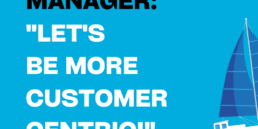The B2B (business-to-business) buying journey represents the steps your customer goes through to satisfy a specific business need. It maps out the various stages from business need conception to need fulfillment. The figure below shows such buying journey in blue.

In reality, your B2B customer rarely follows this process as smoothly as depicted here. Their buying journey is normally characterized by a lot of back and forth across the various steps. The reasons for a more chaotic reality are plentiful: company priorities are re-evaluated, budgets are reallocated, problems redefined and reassessed, people change roles, internal politics cause delays, etc. The list is long why your customer’s buying journey is effectively rarely this linear. And this can be highly frustrating from a supplier’s and sales manager’s perspective since timelines, success factors, and probability to secure a successful sale change constantly.
At the same time, such a buying journey is also highly inefficient from a customer’s point of view. The many reiterations that can occur cost a lot of time, resources, and money to their organization as well. Delays in making decisions to buy despite a clearly defined business need to do so are rarely viable options for any business in today’s fast-paced world.
To harness these inefficiencies is the main driver for your customers and their company leaders to nominate a dedicated function to serve as facilitator and consultant to this buying process: the procurement function.
How does the procurement function get involved in your customer’s buying journey?
Procurement effectively assumes responsibility for the B2B buying journey from start to finish. It does so by applying its own strategic sourcing process.
The buyer’s involvement spans from business need identification to solution implementation, end to end. Their strategic sourcing process, depicted here in pink, bolts onto the existing customer’s buying journey.
The main task for the buyer as part of step 1 of the strategic sourcing process is to gauge the real underlying business need of their individual stakeholders and the company overall.
The expectation for the procurement function at this stage is to bring in an external, supply chain view into the company. This effectively means highlighting risks, outlining external market opportunities, offering industry insights and supplier solutions, but also challenging established views and previous decisions. The buyer serves as an internal commercial consultant and sounding board. They are expected to play devil’s advocate with regards to the customer’s wants. The ultimate result of step 1 is the definition and alignment of the exact business needs and hence the determination of the customer’s real demands.
In step 2, and based on the previous alignment on demand, the buyer performs a more thorough internal company and external market analysis to identify how the underlying business need can be best met. This leads to an evaluation of internal and external capabilities to determine if the company can cater to their needs self-sufficiently or if indeed external solutions are required, and if so, which ones are accessible to the organization. For example: Should the business need be addressed via an in-house developed product, or is it better to acquire it from the outside world? What are the company’s internal strengths and weaknesses regarding the underlying business need? What supplier skills and market opportunities exist and could benefit the organization to achieve its goals quicker, better, and more efficiently? What are potential industry challenges that could prevent access to such external solution?
Steps 1 and 2 of the sourcing process lay the analytical foundation for creating the buying strategy for procurement that follows next (step 3). Here the buyer determines how to optimally approach the sourcing of the required item/service in line with the goals agreed with their stakeholders and the assessment of the industry, and supplier markets.
These sourcing strategies are sometimes called “category plans”. They can span multiple years, defining “the what” and “the how”: what does procurement specifically need to deliver (with regards to the wider business needs)? And how will procurement deliver against these goals over time? The HOW is the essential element of the sourcing strategy. It sets out specific interventions procurement will drive in the underlying supplier markets to achieve their goals: e.g., it defines the number of supply sources to work with, maps out a development and management plan for the supplier relationships, determines the level of investment into supplier capabilities, and outlines eventual market or technical interventions, etc.
The sourcing strategy is effectively the buyer’s game plan, determining what to buy, from whom to buy, and how to do so. The influence these sourcing strategies and hence the buyers have on the overall direction of travel for the customer heavily depends on their level of procurement maturity and the credibility buyers have within their own company.
As part of this step, the buyer also defines their buying tactics. This includes, for example, decisions on optimal contract length, when and if to engage in either a tendering, auctioning, or a private negotiation process with the targeted suppliers.
This leads us to step 4, which is the actual supplier selection process, the executional part of the sourcing strategy. Here, suppliers are assessed, benchmarked, and selected based on their ability to meet the business needs and the goals set out in the sourcing strategy. Many professional buying teams perform this step without any stakeholder involvement since business needs and expected results were fully aligned and cross-checked with the internal stakeholders as part of the previous steps. Suppliers are selected by procurement with a set of tactical tools such as auctions (e.g., a reverse or Dutch auction), tender processes (e.g., RFQ or RFP), or private negotiations.
Step 5 in the strategic sourcing process consists of putting in place a contractual framework with the selected suppliers. It is a key step in the strategic sourcing process and plays directly into one of procurement’s main KPIs: assuring supply to the company at all times, which effectively means fending off any unnecessary risks to the business. This KPI requires procurement to initially frame and define the exact risks the company is engaged in and exposed to when entering a supplier relationship. This framing process is done (to a large part) by putting the commercial relationships with the selected suppliers into robust frameworks, a contract.
Supplier relationship management is the last step in the procurement process and is mostly triggered after a commercial accord has been found with an external provider. It is one of the most crucial steps for a buyer. Most of the KPIs that the procurement function is assessed on, are addressed in this step. It is here where you, as the supplier, can significantly contribute to their success and build a long-lasting and trusting relationship with procurement and the customer.
Supplier relationship management effectively evolves around two dimensions, one, the physical execution of what has been agreed upon with the supplier (e.g., the delivery of the product or service), and two, the further solidification of the relationship through measures that create exponential value (e.g., a continuous improvement of the delivery).
Supplier relationship management, or SRM, plays a key role in procurement, especially for expenditure items that are considered strategic and hence managed as part of a more exhaustive category plan. The supplier relationship management process is effectively the application and execution of the sourcing strategy on a more dedicated supplier level. It encompasses the supervision of the execution of the supply agreements in all its facets but also, and more importantly, the development of the relationship into the desired strategic direction.
What does the role of procurement in the customer’s buying journey mean for you as a sales manager?
To succeed in this new reality, sales teams need to build a thorough understanding of this more complex B2B buying journey and the role of their procurement counterpart in the sales process: What is the buyer’s approach to managing the customer’s buying journey? How do they conduct their strategic sourcing process? How do they build and maintain the relationship with suppliers?
Understanding their ways of working and what makes procurement tick will allow sales teams to meaningfully engage with the buyers in their strategic sourcing process, long before a commercial negotiation takes place (step1-3).
In the most advanced companies, the buyer has effectively become the key stakeholder to work with. In some organizations, the boundaries within the buying journey are blurred, making it difficult for an outsider to readily determine at what stage responsibilities are transferred, where the user is still fully in charge, and where procurement has been tasked to manage the steps in the buying journey independently. The more mature the procurement function is, the more power and influence it generally possesses over the buying journey. These intricacies need to be fully understood by the sales manager to avoid harming any stakeholder relationships.
Procurement’s general, more empowered role offers many opportunities to sales teams. When a trusting relationship is established, procurement can serve as the ultimate sales enabler in its role as an influencer of business needs, of demand and product specifications. The function drives decision-making processes and initiates projects, often providing a direct avenue for sales managers to present their solutions to key stakeholders in the customer’s organization (e.g., senior leadership teams).
Procurement’s role as commercial contact offers new suppliers, that potentially were previously disregarded, an opportunity to win business for the first time without needing to spend resources on assessing where the decision-making power resides.
It equally allows incumbent suppliers to reach a much broader audience within the customer’s organization than ever before. It is in procurement’s interest to deploy great supplier capabilities across all business units in their organization. The buyer can serve as the internal advocate for the supplier, helping to sell their solutions to the various outlets in their business.
Your B2B customers no longer just want a great product or service from their suppliers but expect to be thoroughly consulted on how to best address their respective business challenges. Managing the customer’s buying journey with its multiple stakeholders, and an ever more empowered procurement function is key to presenting yourself as that commercial consultant your customer is longing for.
Embrace this new buying journey your customer is on. Travel it well by engaging with procurement early.


